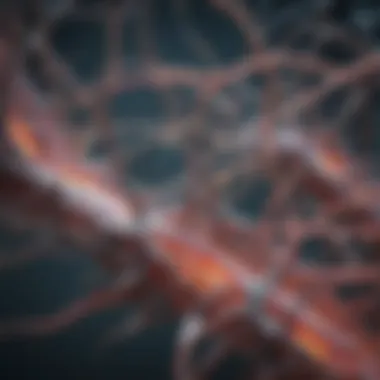Harnessing Neuroplasticity for Stroke Rehabilitation


Intro
The study of neuroplasticity provides insightful perspectives on how the brain adapts and reorganizes itself, especially after traumatic events like a stroke. Stroke rehabilitation aims to facilitate recovery through various therapeutic approaches. The process underscores the potentials of neuroplasticity in restoring functions lost due to strokes. This area of research is not just theoretically fascinating; it holds visceral implications for stroke recovery outcomes. Understanding neuroplasticity mechanisms opens doors to innovative rehabilitation strategies, ensuring a more effective recovery path for patients.
Recent Advances
Recent advancements in understanding neuroplasticity have further illuminated its critical role in stroke rehabilitation. Breakthroughs reveal how the brain's ability to reorganize itself can lead to significant improvements in motor skills and cognitive functions. These advances hinge on our understanding of neural networks and their remarkable adaptability.
Latest Discoveries
Researchers have made remarkable discoveries regarding how specific activities can enhance neuroplasticity post-stroke. Studies have shown that engaging in repetitive movements can stimulate motor recovery. This phenomenon is often referred to as motor learning, which exemplifies how practice enhances neural circuits involved in movement. Moreover, the brain's engagement in complex tasks can spark neurogenesis, the growth of new neurons, contributing to rehabilitation success.
Technological Innovations
Technological advancements play a pivotal role in harnessing neuroplasticity for stroke recovery. Innovations such as brain-computer interfaces and virtual reality therapies are showing promising results. These technologies create immersive environments that challenge the brain, encouraging novel neural connections. Notably, devices like the Bioness 00 enable precision in rehabilitation exercises, making therapy more effective and engaging.
Methodology
Understanding how neuroplasticity can be optimized requires a well-defined methodology.
Research Design
The exploration of neuroplasticity in rehabilitation employs various research designs, including randomized controlled trials, longitudinal studies, and observational studies. Each design provides essential insights into how different rehabilitation strategies impact neuroplastic outcomes.
Data Collection Techniques
Data collection techniques in this field often involve both qualitative and quantitative approaches. Surveys and interviews can provide subjective insights into patient experiences, while objective measures may include brain imaging techniques like fMRI and PET scans, offering concrete evidence of neural changes during rehab.
"Neuroplasticity is not just a biological phenomenon; it is the very foundation of stroke recovery."
This quote encapsulates the essence of neuroplasticity in aiding stroke recovery.
The landscape of stroke rehabilitation is evolving, becoming increasingly informed by the principles of neuroplasticity, driving the exploration of methodologies that harness this malleability of the brain for therapeutic use. As practitioners and researchers continue to unveil the intricacies of the brain's adaptive capabilities, the potential for improved recovery outcomes remains promising.
Preamble to Neuroplasticity
Neuroplasticity refers to the brain's remarkable ability to reorganize itself by forming new neuronal connections throughout life. This capacity is crucial, especially in contexts such as stroke rehabilitation where recovery depends largely on the brain's adaptive processes. Understanding neuroplasticity provides insight into how various rehabilitation strategies can be optimized to support the healing process for stroke patients.
Neuroplasticity has significant benefits that extend beyond recovering lost functions. It can improve cognitive abilities, enhance emotional regulation, and even increase resilience to future neurological challenges. By exploring this topic, we not only uncover mechanisms that enhance recovery but also identify ways to implement strategies that leverage these mechanisms effectively during therapy.
Another critical consideration is that neuroplasticity varies among individuals. Factors like age, severity of the stroke, and pre-existing conditions can influence outcomes. Recognizing these variations is vital in tailoring rehabilitation approaches, ensuring that they align with each patient's specific needs and capacities. With this understanding, healthcare professionals can foster environments that encourage optimal brain recovery, ultimately supporting more successful rehabilitation outcomes for stroke patients.
Definition and Significance
Neuroplasticity encompasses various processes, including synaptic plasticity, which involves changes in the strength of connections between neurons, and structural plasticity, where alterations occur in the brain's physical structure. The significance of neuroplasticity is underscored when considering its role in recovery from injuries and neurologic disorders. After a stroke, specific areas of the brain may become damaged, affecting motor skills, language, and other vital functions. By engaging the remaining healthy brain regions, neuroplasticity enables patients to recover abilities that may be impaired due to injury.
Effective rehabilitation strategies capitalize on this adaptive capacity of the brain. Therapies that promote movement, address cognitive deficits, and employ repetitive practice can effectively drive neuroplastic changes. Thus, grasping the definition and significance of neuroplasticity enriches our understanding of how best to support patients in their recovery journey.
Historical Context
The study of neuroplasticity has evolved significantly over the years. Initially, the prevailing belief was that the brain was largely fixed in its structure and function after a certain developmental stage. Research from the late 20th century began to challenge this notion, with empirical evidence demonstrating that the brain could adapt and reorganize itself in response to experiences and injuries.
In the 1960s, studies on sensory deprivation in animals offered early indications of neuroplasticity, showing that when sensory input was altered, the brain could adapt its structure and function accordingly. Advances in neuroimaging technologies in the subsequent decades further propelled research in this area, allowing scientists to visualize changes in brain activity and structure in real time. This historical backdrop provides a crucial context for understanding the current applications of neuroplasticity in stroke rehabilitation and the therapies that leverage its mechanisms.
Understanding Stroke
Understanding the complexities of stroke is essential for comprehending the role of neuroplasticity in rehabilitation. Stroke can vary significantly in type and impact, which in turn influences recovery processes and potential outcomes. Stroke is a leading cause of long-term disability worldwide, making it a critical area of focus for researchers, healthcare providers, and families alike. Therefore, detailing the types and epidemiological aspects of stroke provides a foundational context for exploring rehabilitation strategies involving neuroplasticity.


Types of Stroke
There are two primary types of stroke: ischemic and hemorrhagic.
- Ischemic Stroke: This occurs when a blood vessel supplying blood to the brain is obstructed. The blockage can result from a blood clot or narrowing of the arteries. They are the most common type of stroke, accounting for about 87% of all cases. Ischemic strokes can be further classified into two types:
- Hemorrhagic Stroke: This type involves bleeding in or around the brain due to a ruptured blood vessel. There are two main subcategories:
- Thrombotic Stroke: A blood clot forming in an artery supplying blood to the brain.
- Embolic Stroke: A clot that travels to the brain from another part of the body.
- Intracerebral Hemorrhage: Bleeding that occurs within the brain tissue itself.
- Subarachnoid Hemorrhage: Bleeding that occurs in the space between the brain and the tissues covering it.
Each stroke type presents distinct challenges during recovery. Thus, understanding the specific attributes of ischemic and hemorrhagic strokes is important, as it shapes the rehabilitation strategies that leverage neuroplasticity.
Epidemiology and Impact
The impact of stroke is profound, affecting millions of individuals, families, and healthcare systems. According to the World Health Organization, approximately 15 million people globally suffer from a stroke each year. Out of these, about 5 million die, and another 5 million are left permanently disabled.
Key statistics include:
- Stroke is the second leading cause of death worldwide.
- It is a leading cause of serious long-term disability among adults.
- The incidence of stroke increases with age, but it can occur in younger populations too, often as a result of lifestyle factors.
The consequences of stroke extend beyond physical impairment, often leading to cognitive dysfunction, emotional issues, and a reduced quality of life. These repercussions highlight the critical need for effective rehabilitation techniques that harness the brain's ability to adapt and recover, which is where neuroplasticity comes into play.
Understanding stroke types and their impact is essential for developing effective neurorehabilitation strategies. Without grasping the specific nature of the stroke, intervention cannot be appropriately tailored.
Neuroplasticity Mechanisms
Neuroplasticity encompasses various mechanisms that allow the brain to adapt following injury or disease, such as stroke. Understanding these mechanisms is crucial for developing effective rehabilitation strategies. It highlights how the brain reorganizes in response to experiences and challenges, which is particularly significant in stroke recovery where the goal is to regain lost functions. Exploring these mechanisms offers insights into how therapeutic interventions can maximize rehabilitation outcomes for patients.
Cellular Level Changes
At the cellular level, neuroplasticity involves several key processes, including changes in synaptic strength and the growth of new neuronal connections. Upon damage, brain cells may undergo a transformation that permits them to compensate for lost functions. This adaptability is particularly relevant in stroke rehabilitation. For instance, when certain areas of the brain are affected, adjacent healthy areas can develop new pathways to take over the functions of the damaged tissue.
Some mechanisms include:
- Synaptic plasticity: This refers to the strengthening or weakening of synapses based on activity. Long-term potentiation (LTP) is a type of synaptic plasticity that increases the strength of a synapse, facilitating improved communication between neurons.
- Dendritic growth: The brain can form new dendrites, the branches of neurons that receive signals, enhancing the connectivity needed for recovery.
These cellular-level changes are foundational for functional recovery after a stroke, allowing individuals to regain abilities and skills.
Functional Reorganization
Functional reorganization refers to the brain's capability to shift functions from damaged regions to intact regions. This reorganization can be initiated through various rehabilitation strategies that stimulate affected areas, thereby encouraging the brain to create new functional networks. Research indicates that the brain's ability to adapt functionally is critical during the post-stroke recovery period.
Some aspects include:
- Cortical mapping studies: Advanced imaging techniques, like fMRI, reveal that as stroke patients engage in rehabilitation, areas adjacent to injury often take over the injured region's functions. This demonstrates the brain's capacity to adapt and reorganize.
- Task-specific training: Engaging in activities that require specific motor skills can promote functional reorganization. Repetition and practice are key components, as they help solidify newly formed brain connections.
Overall, functional reorganization highlights the brain's remarkable ability to adapt, which offers hope for innovative recovery methodologies.
Neurogenesis
Neurogenesis, the process by which new neurons are formed in the brain, plays a vital role in neuroplasticity. While traditionally thought to occur only during development, it is now recognized that neurogenesis can happen in adulthood, particularly in response to neural injuries such as strokes. This aspect of neuroplasticity is particularly promising as it suggests potential for not just recovery but also regeneration of lost brain cells.
Key points include:
- Hippocampal neurogenesis: The hippocampus is one area where new neurons are continually generated. Studies show that increased physical activity and cognitive engagement can boost neurogenesis, potentially enhancing recovery outcomes.
- Impact of environment: A supportive, enriched environment can foster neurogenesis by promoting learning and recovery strategies. This reinforces the idea that rehabilitation should not only focus on physical exercises but also on creating stimulating experiences for patients.
In summary, neurogenesis is a promising area of research that can harness the brain's natural capabilities to recover from strokes. This encompasses a wider understanding of how lifestyle modifications can impact rehabilitation processes.


Role of Neuroplasticity in Stroke Recovery
Understanding the role of neuroplasticity in stroke recovery is critical. It refers to the brain's ability to reorganize itself by forming new neural connections. After a stroke, the brain often experiences significant damage. Neuroplasticity allows for compensatory mechanisms that can lead to improved function. This process is especially important as it provides hope for recovery.
Neuroplasticity does not happen in isolation. Varied rehabilitation approaches can encourage these biological changes. Techniques like physical therapy can stimulate the brain networks involved in motor control. With persistent practice, patients can regain lost functions.
Rehabilitation Approaches
Rehabilitation is a foundational aspect of stroke recovery. Different strategies can promote neuroplasticity. Key approaches include:
- Task-oriented training: This involves practicing specific tasks. It allows the brain to work on targeted skills, enhancing motor pathways.
- Goal-directed training: Setting personal goals helps patients remain engaged. Focused effort can lead to meaningful improvements in abilities.
- Mixed modalities: Incorporating various activities keeps the rehabilitation process dynamic. This variety helps in targeting different brain areas, supporting overall recovery.
In addition to individualized rehabilitation, therapy needs to be intensive. Studies show that higher repetition of tasks leads to greater neural changes. Therefore, focused efforts on rehabilitation can yield positive outcomes.
Case Studies and Evidence
Numerous case studies provide insight into the effectiveness of neuroplasticity in stroke recovery. For example, studies conducted on Constraint-Induced Movement Therapy (CIMT) demonstrate significant improvements in patients who engage in forced use of their affected limbs. These findings suggest that targeted therapy significantly aids recovery.
Another compelling piece of evidence is the use of technology like virtual reality. Research has shown that patients exposed to immersive technologies exhibit enhanced motor skills and cognitive functions. Such interventions highlight how integrating technology can augment traditional rehabilitation techniques.
"Neuroplasticity is the brain's way of adapting to change, and understanding its role in rehabilitation opens avenues for innovative therapies."
In summary, neuroplasticity plays an essential role in stroke recovery. Various rehabilitation approaches can foster this resilience in the brain. Continued exploration into effective interventions can lead to better outcomes for stroke survivors.
Therapeutic Techniques Promoting Neuroplasticity
Understanding and utilizing therapeutic techniques that promote neuroplasticity is essential in stroke rehabilitation. It allows healthcare professionals to design interventions that significantly improve recovery outcomes. Neuroplasticity refers to the brain's ability to reorganize itself by forming new neural connections throughout life. Within the context of stroke recovery, the right therapeutic techniques can harness this ability to facilitate motor function recovery and cognitive rehabilitation. The following sections will discuss three notable methods: Constraint-Induced Movement Therapy, Mirror Therapy, and the use of Virtual Reality and Robotics in rehabilitation.
Constraint-Induced Movement Therapy
Constraint-Induced Movement Therapy (CIMT) is a groundbreaking approach aimed at improving the functionality of an impaired limb. The technique involves temporarily restricting movement of the unaffected limb. This forces the patient to use the affected limb, thus promoting engagement and practice, which is essential for recovery. The rigorous practice is based on principles of behavioral psychology and aims to counteract learned non-use of the affected limb.
Benefits include:
- Increased use of the affected extremity in daily activities.
- Enhanced cortical reorganization in the brain, aiding in motor recovery.
- Psychological benefits that arise from increased engagement in rehabilitation.
However, clinicians should consider physiological and individual patient factors. Assessing the readiness and mental state of patients is necessary for the effective implementation of CIMT. This approach requires ongoing monitoring and encouragement to ensure that patients stay motivated and can track their progress.
Mirror Therapy
Mirror Therapy employs visual feedback to facilitate motor recovery. During this therapy, patients look into a mirror that reflects the movement of their unaffected limb. This illusion creates a perception of movement in the affected limb, stimulating neural activity associated with voluntary movement. Patients perform simple movements, which can help enhance motor function.
Key aspects include:
- Promoting neural activation in regions responsible for movement.
- Improving motor function, particularly in cases of hemiparesis.
- Boosting patient motivation and involvement in therapy.
Although this therapy is easy to administer, outcomes can vary based on individual differences. Patient adherence is a crucial element in the success of mirror therapy. Continuous encouragement and proper guidance by professionals can enhance engagement.
Virtual Reality and Robotics in Rehabilitation
Emerging technologies such as Virtual Reality (VR) and robotics are opening new avenues for promoting neuroplasticity. These tools can create immersive and engaging environments to encourage movement and cognitive exercises tailored to individual needs. Virtual environments allow patients to practice tasks in a safe space, while robotic devices can assist in physical movement, providing feedback to enhance performance.
Advantages include:
- Customized rehabilitation experiences based on specific patient needs.
- Real-time feedback that can lead to improved skill acquisition.
- Engagement through interactive tasks that keep patients motivated.
Considerations for these methods include the availability of technology and addressing the potential learning curve. Ensuring that patients are comfortable with the technology is essential for achieving positive outcomes. Overall, these advancements possess the potential to revolutionize stroke rehabilitation by making therapy more effective and engaging.


"Neuroplasticity is increasingly recognized as a significant factor in rehabilitation, with various techniques contributing to recovery."
Understanding these therapeutic techniques is pivotal for professionals navigating stroke rehabilitation, as they provide a foundation for enhancing neuroplasticity and promoting recovery.
Barriers to Effective Neuroplasticity
Neuroplasticity is a central theme in stroke rehabilitation, offering immense potential for recovery. However, realizing this potential is not straightforward. There are significant barriers to effective neuroplasticity that need addressing to optimize rehabilitation outcomes. Understanding these barriers is crucial for clinicians, patients, and researchers alike.
This section explores two main categories of obstacles: physiological constraints and psychological factors. By identifying these barriers, professionals can develop targeted interventions and strategies to enhance neuroplasticity during rehabilitation.
Physiological Constraints
Physiological constraints can significantly impede the brain's ability to reorganize and recover after a stroke. Following a cerebrovascular accident, various changes occur in the brain's structure and function, potentially limiting neuroplasticity.
- Extent of Damage: The severity of the stroke can dictate the degree of neuronal damage. Extensive injury may hinder neuroplastic changes, as there are fewer healthy neurons available to be reorganized or retrained for new functions.
- Age-Related Factors: Older adults may experience reduced neuroplasticity due to natural aging processes. Age-related decline in synaptic plasticity reduces cognitive and motor function recovery, creating a gap in rehabilitation effectiveness.
- Comorbidities: Other health conditions, such as hypertension or diabetes, may complicate recovery. These ailments can affect brain health and blood flow, impairing neuroplastic potential.
"Physiological impacts on neuroplasticity must be understood to devise effective rehabilitation programs."
- Neuroinflammation: After a stroke, the brain may undergo neuroinflammatory responses, which can inhibit neurogenesis and synaptic plasticity. Persistent inflammation may thus reduce the effectiveness of rehabilitation strategies.
Understanding these barriers allows healthcare providers to consider individualized rehabilitation plans. Acknowledging the patient's unique physiological profile can lead to better-targeted therapies and support.
Psychological Factors
Psychological aspects play a vital role in how patients engage with rehabilitation and utilize neuroplasticity. Emotional and cognitive conditions can act as barriers to effective recovery.
- Motivation: A patient’s motivation directly influences participation in therapeutic exercises. Low motivation can stem from feelings of despair or frustration about the recovery process, leading to reduced efforts and engagement.
- Cognitive Impairments: Stroke can impair cognitive functions such as attention, memory, and executive functions. These impairments may hinder a patient's ability to grasp new tasks, impacting their engagement in rehabilitation activities.
- Anxiety and Depression: Emotional issues like anxiety and depression are common post-stroke. They can further complicate rehabilitation by creating psychological barriers that inhibit learning and adapting.
- Social Support: A lack of social support can exacerbate difficulties in recovery. Patients without a strong support network might feel isolated, impacting their mental health and rehabilitation efforts.
Addressing psychological factors involves providing a supportive environment. Clinicians must integrate mental health support into rehabilitation plans to promote emotional well-being alongside physical recovery.
In summary, barriers to neuroplasticity span both physiological and psychological realms. Understanding these constraints is essential to developing effective and comprehensive rehabilitation strategies.
Future Directions in Research
The landscape of stroke rehabilitation is continuously evolving, with neuroplasticity serving as a focal point of exploration. As our understanding deepens, it becomes evident that future research directions can significantly enhance recovery outcomes. By investigating the nuances of brain adaptation, researchers can innovate methodologies that capitalize on neuroplasticity’s potential. These developments hold promise for tailoring rehabilitation to individual needs, thereby optimizing recovery.
Innovative Approaches to Stroke Rehabilitation
Innovative approaches are pivotal in advancing stroke rehabilitation. Current strategies often encompass a blend of traditional therapies and newer techniques inspired by neuroplasticity. For instance, personalized rehabilitation programs can utilize data from brain imaging studies to inform treatment plans. Individualization allows for more effective targeting of specific deficits that stem from stroke.
Therapeutic practices such as combining physical therapy with cognitive training offer dual benefits, engaging multiple brain areas. These approaches not only stimulate physical recovery but also enhance cognitive functions that may have deteriorated. Additionally, community-based interventions can extend the reach of rehabilitation, fostering engagement among stroke survivors in a supportive environment.
Emerging Technologies
Emerging technologies are transforming the sphere of stroke recovery, making it crucial to explore these innovations further. Tools like neurofeedback, which provides real-time data on brain activity, can empower patients to actively participate in their rehabilitation. This bi-directional communication can enhance motivation and foster an environment of continuous learning.
Moreover, advancements in wearable devices enable continuous monitoring of patient progress. Such data collection can inform healthcare providers about individual recovery trajectories, allowing for timely adjustments in therapeutic strategies. The integration of artificial intelligence in rehabilitation programs may soon offer predictive analytics, guiding practitioners in making more informed decisions regarding treatment paths.
In summary, future research should focus on harnessing innovative approaches and emerging technologies to refine stroke rehabilitation strategies. This pursuit holds potential to significantly enhance how we approach recovery, making the journey more personal and effective for stroke survivors.
Finale
The exploration of neuroplasticity in the context of stroke rehabilitation is crucial for advancing recovery strategies. The understanding that the brain can reorganize itself, both structurally and functionally, presents significant opportunities for those affected by stroke. This adaptability emphasizes the need for tailored rehabilitation approaches that leverage these neurological capabilities. The implications of neuroplasticity are profound, influencing not only therapeutic practices but also patient outcomes and overall quality of life.
Summary of Key Points
Throughout this article, several key points emerged regarding neuroplasticity and its relationship to stroke rehabilitation:
- Definition of Neuroplasticity: Neuroplasticity refers to the brain's ability to change and adapt as a result of experience. It is fundamental in recovering from neurological injuries, including strokes.
- Mechanisms of Change: Various mechanisms, such as cellular changes, functional reorganization, and neurogenesis, play a role in rehabilitation.
- Therapeutic Techniques: Approaches such as Constraint-Induced Movement Therapy, Mirror Therapy, and the use of Virtual Reality demonstrate how neuroplasticity can be encouraged in clinical settings.
- Barriers and Challenges: Factors such as physiological constraints and psychological factors can hinder the effectiveness of neuroplasticity in recovery.
- Future Directions: Ongoing research and innovative technologies hold promise in enhancing rehabilitation outcomes for stroke survivors.
Implications for Practice
The insights gathered from the study of neuroplasticity bear significant implications for clinical practice in stroke rehabilitation:
- Personalized Rehabilitation Plans: Understanding individual patient's neuroplastic potential could lead to more effective, personalized rehabilitation approaches. Clinicians should assess each patient’s specific needs and adapt strategies accordingly.
- Multidisciplinary Approaches: Collaboration among healthcare professionals is essential for developing comprehensive rehabilitation plans. Integrating physical therapists, occupational therapists, and neurologists can enhance treatment outcomes.
- Incorporating Technology: Embracing emerging technologies can augment traditional therapies, making rehabilitation more engaging and effective. Technologies like virtual reality offer new ways to stimulate brain activity.
- Psychological Considerations: Addressing psychological factors, such as motivation and mental resilience, is vital to harnessing neuroplasticity effectively. Support systems and counseling can help patients navigate their recovery journey.















